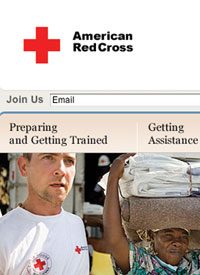
It should never be said that Americans are stingy, especially when natural disaster strikes. Hurricanes and storms throughout the United States in the past several years, such as Hurricane Katrina in 2005, have inspired Americans to give not only millions of dollars but also thousands of hours of time for rebuilding and humanitarian efforts. Earthquakes, floods, tsunamis, tornados, and hurricanes in other parts of the world have received no less assistance from generous Americans.
Last month’s magnitude-7 earthquake 10 miles southwest of Port-au-Prince, Haiti, has occasioned yet another outpouring of private U.S. aid. Rebuilding Port-au-Prince will take years, and American support for the people of Haiti will no doubt continue for a long time. However, in only the first 17 days after the quake — as of January 29 — generous private donors from the United States had already sent over $560 million to the beleaguered island country, according to the Chronicle of Philanthropy. So many agencies and individuals have all stepped up to the plate that it would be impossible to list them all, but following is a smattering of the benevolence displayed by Americans.
Secular Relief Agencies
Many U.S.-based relief agencies were already on the ground in Haiti when the earthquake struck, as they regularly support the underdeveloped country. However, they have been able to significantly ramp up their humanitarian efforts owing to the increased giving of Americans. The Chronicle of Philanthropy notes that the American Red Cross topped the list of humanitarian agencies’ receipt of aid for Haiti, at over $198 million as of January 29. Redcross.org reports that the flood of donations has enabled the organization to provide over three million prepackaged meals, drinking water and water-purification tablets, hygiene items, tents, blankets, and blood products for much-needed transfusions. Additionally, they are able to pay for the transportation of hundreds of Creole-speaking U.S. volunteers to function as interpreters.
Doctors Without Borders is another organization that was already serving in Haiti prior to the quake. Though several of their hospitals were destroyed in the earthquake, the increased donations allowed them to bring in inflatable hospitals and many extra medical personnel. Doctorswithoutborders.com emphasizes that 100 percent of their funding comes from private donations.
Other privately funded secular charities going above and beyond to provide care to Haiti are Goodwill, Sow a Seed, and Hope to Haiti.
Christian Relief Ministries
Many Christian relief agencies also maintain a full-time presence in Haiti, and were already in the country to provide assistance, but American generosity has allowed them to significantly increase their aid. The many organizations working full time to help the Haitians include Samaritan’s Purse, Children of the Nations, the Lutheran Church, the Mennonite Central Committee, the Christian Broadcasting Network’s Operation Blessing, the Hands and Feet Project, Northwest Haiti Christian Mission, and many others.
These groups provide not only physical care, but spiritual as well. Volunteers for these organizations pour in from across America, and generous American dollars allow the missionary groups to provide food, blankets, clothing, medical care, diapers, drinking water, and even water-purification units to provide tens of thousands of gallons of drinking water daily.
So many U.S. medical personnel are willing to give of their time that they are actually being turned away. Northwest Haiti Christian Mission has a waiting list of volunteers, which they are planning on using later for ongoing follow-up care for the patients now being treated. This is definitely a long-term mission for these Christian groups, made possible by the thoughtful giving of caring Americans.
Small Business and Individual Relief Efforts
In addition to the labor of thousands of medical volunteers, cash and goods are supplied in abundance. Where do the money and items donated to the groups noted above come from? Well, ultimately the cash comes out of the bank accounts of generous donors, and the goods are shared from America’s abundance. Sometimes, though, both cash and goods take a rather innovative route to their destination, as everyday people respond to creative requests from their fellow Americans. Many of these efforts are ongoing, so totals are not available yet, but here are just a few of the endeavors underway:
When he learned of the Haitian destruction, disabled veteran Don Turner of Lufkin, Texas, organized a clothing drive through the National Guard Armory. He had secured a donated 53-foot trailer, but certainly didn’t expect the response he got. That trailer and another were stuffed full of clothing, shoes, and water to be taken to Houston on January 26 for transfer there to Haiti. Being disabled, Turner knew he would be unable to unload so many donations, so the night before his trip to take the trailers to Houston, he put out a desperate plea for help via Texas’ KTRE Channel 9. Workers at Houston’s JV Industrial Co. in Houston responded to that plea, supplying enough manpower, pallets, and even a forklift to help, getting the trucks unloaded in just a few hours.
SoFly, a group of female photographers from South Florida, held a benefit shoot on January 30 to support Sow a Seed, a nonprofit organization of Haitian and American professionals dedicated to helping disadvantaged children in Haiti. The photographers held 30-minute sessions on January 30, at $100 per session, with 100 percent of the proceeds going to purchase supplies for Haiti orphanages, raising over $2,500.
The Valley Courier of Alamosa, Colorado, reported that a local company, Del Mar Carpet One, has decided to donate 10 percent of all their sales from January 18 through February 13 to their local American Red Cross chapter for direct donation to Haiti.
Marie Boyd of Newport News, Virginia, decided to raise funds and awareness by camping out for seven days at a local stadium. She brought only water and blankets, and accepted only one meal a day, which had to be donated by a visitor. Virginia’s Daily Press reported on January 27 that she single-handedly raised $4,000 to give to the Red Cross.
Minnesota’s Fox9 told the story of Clint Johnston. The young man was introduced to some of Haiti’s orphans last December and was touched by their plight. When the earthquake hit a few weeks later, he was determined to help. He decided to run the PF Chang Rock ’n Roll Marathon in Phoenix, Arizona, for donations, calling his effort Run 4 Haiti. Fitsugar.com reported that without any training whatsoever, Johnston completed the marathon on January 24, raising almost $4,000 to donate to Danita’s Children, the ministry that runs the Haitian orphanage he visited earlier and is now providing care for earthquake victims.
In Houston, Texas, Sr. Jane Meyer, head of the St. Agnes Academy for Girls, promised to go skydiving if her girls could raise $25,000 for Catholic Relief Services by Ash Wednesday. Well, as of January 29 the school community had raised $42,029, so Sr. Jane must take to the skies. Dubbed The Flying Nun, she told the St. Agnes website, “I’m at the nervous stage right now!” But she says it’s worth it, as she knows that “the money given to Catholic Relief Services goes directly to the cause.”
Quint Tatro knows the value of cash contributions to help Haiti, but also recognizes the value of — peanut butter? Yes. Tatro first visited Haiti in 2003 as part of a mission in the aftermath of a hurricane. He and the mission’s director were unpacking donations and noted that most items were unusable due to being wet or broken — all except for one crate that contained plastic jars of peanut butter. The director told Tatro, “If people only knew they could send peanut butter!” Now, through his website PBForHaiti.com, Tatro’s goal is to purchase as much peanut butter as possible over the next few months to donate to the Northwest Haiti Christian Mission based in Kentucky. Knowing it sounds like a strange effort, Tatro explains that the jars won’t break or spoil, they have a long shelf-life, and the peanut butter is packed with protein and very nutritious. He says of the jars in a YouTube video, “They’re going to go to feed families. It’s very, very simple. It’s a tragedy that’s happened, but hopefully one little jar of peanut butter can make a lasting impact on a family and feed them and make them well.”
These are a very few of the creative fundraising efforts being employed. For every person whose giving is publicized, there are thousands more behind the scenes quietly donating, and all the donors are important.
These are hard times for most Americans. With the country at double-digit unemployment, many are out of work altogether; many have had their work hours and/or pay cut substantially; many have experienced the loss of benefits; and most if not all are suffering the effects of the economic downturn. The fact that, in spite of their own hardships, the everyday people of this country have given so selflessly of what little they have truly demonstrates the Goodness of America.



